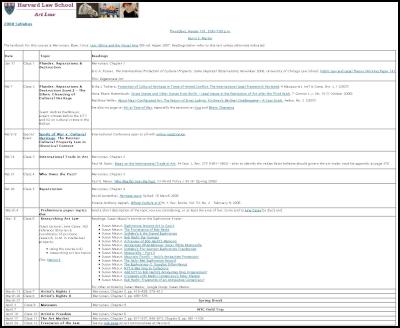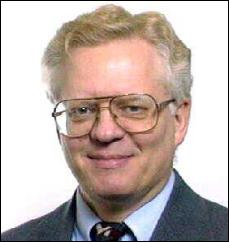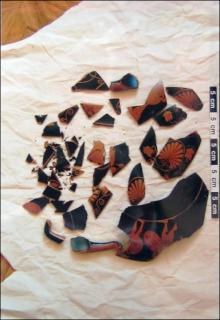Mazur On Euphronios At Harvard Law & Lost Chalice
Mazur On Euphronios At Harvard Law & Lost Chalice
By Suzan Mazur

Click to enlarge
This is one of the most refreshing examples I've seen of how Internet reporting is influencing institutional learning. Unbeknownst to me, at the time that Altenberg! The Woodstock of Evolution? was beginning to “reverberate throughout the evolutionary biology community"-- as Science magazine later reported -- 15 of my stories on the Rome antiquities trial (still underway) involving Giacomo Medici, Bob Hecht and Marion True were included in the curriculum at Harvard Law School, along with a link to one of Karl Meyer’s World Policy Journal articles about disputed art, one by Kwame Anthony Appiah in the New York Review of Books and a few others.

Click to enlarge
Harvard Law School, Art Law 2008 Syllabus
When I discovered the 2008 syllabus, I phoned Harry S. Martin III, who is now Harvard Law School's Henry N. Ess III Librarian and Professor of Law, Emeritus. Harry ("Terry") Martin has served at Harvard Law for 27 years and is currently Visiting Professor of Law and Interim Director, Tarlton Law Library and Jamail Center for Legal Research at the University of Texas School of Law. He is also chair of the advisory board for the May 2009 China-US Conference on Legal Information and Law Libraries.

Harry S. Martin III
Martin told me that aside from the quality of the reporting and the visuals, he found my stories “irreverent” and knew they’d appeal to his students. He said he would have included more of them in the curriculum but couldn’t find them all (there were 30).
Some of my Euphronios story coverage, including bits from Sotheby's Pre-Auction Transcript, is also included in Vernon Silver's forthcoming book (June 2009, HarperCollins) about the Rome antiquities trial and Euphronios wine cup -- The Lost Chalice. Vernon Silver is a Bloomberg news reporter based in Rome.
For the record, there was no courtship of me in June 1990 by Sotheby's, contrary to what Silver writes. I approached Sotheby's as an independent journalist writing a piece about Bunker and Herbert Hunts' hoard on the auction block for The Economist magazine; the piece was commissioned by the marvelous Ann Wroe, then arts editor. It was part of an art looting series I did for The Economist which included a feature on Turkey's Lydian Hoard, one from Bogota on spectacular pre-Columbian gold (meaning fertility to the pre-Columbians) and another on the interaction between museums and the venture capitalists of Wall Street.
As reporters sometimes do exchange notes, in November 2005, I asked Silver if he knew the whereabouts of the Euphronios wine cup which had been sold at the Hunt-Sotheby's auction -- noting that it had the same theme of Sarpedon, son of Zeus as the Euphronios bowl then "owned" by the Metropolitan Museum of Art. I also posed that question on this page in the Nov. 4, 2005 story Euphronios Ancient Art In Court.
Silver emailed me saying he didn’t know a Euphronios Sarpendon cup even existed but our exchange sparked his interest. He later developed a rapport with Giacomo Medici and learned that Medici "owned" the cup, and that it was in pieces following a raid on Medici’s warehouse by the Italian and Swiss police. Silver secured a photo of the shattered cup and shared that image with me. I ran the photo on this page December 1, 2005 in Sotheby's & The Signed Euphronios.

Click for big version
In his book, Silver interviews former Met director Tom Hoving. Hoving was editor-in-chief of Connoisseur in the late 1980s when I met him to shake on a story I then co-authored for the magazine with Turkish investigative journalist Ozgen Acar. I later interviewed Tom Hoving for The Economist Hunt brothers story. Hoving said the following about the Euphronios pieces in response to my question about whether the wine cup could have come from the same site as the Met's Euphronios bowl:
"People did not collect Euphronios in the fifth century BC; we are looking at this with a twentieth-century mind."
And Hoving emailed both me and Silver about the existence of another Euphronios Sarpendon cup, which he said he and then-Met curator of Greek and Roman art Dietrich von Bothmer had seen in a photograph that Bob Hecht showed them in the 1970s. I didn't find Hoving's story credible and decided not to spin my wheels chasing a phantom chalice.
Here's Hoving's email to me, which appeared here in Bob Hecht, The Younger, December 2005.
"Kiddo, I called the guy who was with me
when bobbie h. [Hecht] showed the photo of the early
sarpedon---dietrich von b [Bothmer]. I asked what he
recalled seeing and he said exactly what I remembered, a
Euphronios cup with Sleep and Death marching to the right
with Sarpedon's body on their shoulders like some log of
wood. My eye doesn't forget, it seems. . . ."
I plan to review The Lost Chalice at greater length. But Vernon Silver, who, I believe began his book as part of an Oxford University PhD dissertation, nicely ties up the loose ends of the Euphronios mystery. And his attention to both the mythology and the technique that the Athenian artist used to create his masterpieces is enriching. Silver paints a surprising and sympathetic portrait of Giacomo Medici's youth in Italy during WWII, somewhat reminiscent of the misery and desperation of the Anna Magnani films.
The Hunts' hoard on the auction
block
Suzan Mazur, The Economist 6/23/1990
"I guess it first began with some cheap foreign coins our parents brought home from trips abroad", says Bunker Hunt, talking of his interest in collecting; "That and a boyhood treasure of Indianhead pennies." Back in the oil-boom days of the 1970s, before Colonel Qaddafi nationalised Bunker's oilfield and the silver market collapsed, he and his brother Herbert amassed a quarter-ton of ancient coins and some astonishing pieces of ancient art. These were put up for sale in New York on June 19th to appease the Internal Revenue Service and the Hunts' various creditors, and raised more than $20m. The Hunts have bargained for a 60% commission over the benchmark figure on total sales.
On the night, everyone of note was there; excitement among collectors, dealers and cognoscenti was "absolutely palpable". The pieces included Bunker Hunt's favourites, a signed wine cup and fragment of a vase by Euphronios, the master of Greek vase painting; Sotheby's has never before handled a signed piece by an ancient artist. The cup went for $742,000, the vase-fragment (75% plastic) for $1.7m. A Roman bronze of a young man went for $539,000; an amphora portraying Athena with Pegasus on her shield, originally presented (filled with olive oil) as a prize at the Panathenaic games, fetched $190,000.
This was a landmark sale for ancient coins, establishing them as works of art. A silver Sicilian decadrachm of Agrigentum (410 BC), with a horse-drawn chariot in flight and two eagles devouring a hare on the reverse, fetched $572,000, a record for an ancient coin. A silver decadrachm of Athens honoring the patron goddess, who was shown in a crested helmet, went for $528,000. The Athenian coin is one of only two dozen to survive since they were struck in 465 BC, at the end of the Persian wars.
The chequered history of these artefacts is sometimes as interesting as the pieces themselves. Bunker Hunt got his decadrachm---and many of the other pieces in his collection---through Bruce McNall, the top coin man in Los Angeles and the owner of the LA Kings hockey team. In 1988 Mr McNall tried to sell at auction a number of coins, found in Emali, in Turkey, in 1984, which had been consigned to him by William Koch, an oil heir and a trustee of the Boston Museum of Fine Arts. During the auction the Turkish government appeared, claimed cultural patrimony and regained possession of the coins, which were said to have been smuggled out of the country by the Turkish mafia. Mr McNall's consignment had included an Athenian decadrachm which, for some reason, had been withdrawn from sale; and six of the coins from the Emali hoard are still said to be missing. It is unclear how many are still held by Mr Koch, and Mr McNall has for some weeks been unavailable for comment.
Mystery also surrounds the Euphronios pieces. Thomas Hoving, when he was director of the Metropolitan Museum, was urged by the curator of Greek and Roman art, Dietrich von Bothmer, to buy the signed wine-cup for $70,000 from Robert Hecht, a department-store heir. Mr Hoving declined, because he had just paid $1m for a Euphronios bowl which the Italian government claimed had been looted from an Etruscan tomb. Mr Hecht said he had bought it from a Lebanese businessman whose father had acquired it in a trade for some coins; but he was arrested in both Italy and Turkey on charges of buying looted antiquities.
[Note: Hecht later confronted me about this story in the stairwell at an art exhibit, pulling back his arm in an attempt to punch me in the face -- I am advised this constitutes assault.]
Mr Hoving did not wish to burn his fingers again.
Could the wine-cup have been excavated from the same site as the Metropolitan's bowl? Mr Hoving says it is impossible. "People did not collect Euphronios in the fifth century BC; we are looking at this with a twentieth-century mind."
Mr von Bothmer, who has recently retired from the Met, said he first learnt of the existence of the cup "in Norway" in 1971, when it was said to be worth $15,000. "There is no source to a cup", he was quoted as saying at the time; "a cup is a cup." However, other art experts have said the Etruscans often included more than one costly piece in the tombs of prominent people; and Italy still contends that the cup is of questionable origin.
The Hunts also wound up with a number of the Met's ancient coins, among them a Camarina tetradrachm with Heracles in a lionskin headress, and a coin commemorating the Roman Emperor Titus. These were deaccessioned and sold, a year after the acquisition of the Euphronios vase, "for important purchases, particularly Greek and Roman art objects", as Mr Hoving said at the time of the sale. There is speculation that the coins were somehow part of the Euphronios trade.
At any rate, it is all out of Bunker and Herbert's hands now. How do they feel about losing their treasured vignettes of classical history? "Not very good. It had to be done," says Bunker Hunt sadly.
 Suzan Mazur's stories on art and antiquities have been
published in The Economist, Financial Times, Connoisseur,
Archaeology (cover) and Newsday. Other reports have appeared
on PBS, CBC and MBC. She has been a guest on McLaughlin,
Charlie Rose and various Fox Television News programs.
Email: sznmzr@aol.com
Suzan Mazur's stories on art and antiquities have been
published in The Economist, Financial Times, Connoisseur,
Archaeology (cover) and Newsday. Other reports have appeared
on PBS, CBC and MBC. She has been a guest on McLaughlin,
Charlie Rose and various Fox Television News programs.
Email: sznmzr@aol.com


 Eugene Doyle: The Fall Of Saigon 1975 - Fifty Years Of Repeating What Was Forgotten
Eugene Doyle: The Fall Of Saigon 1975 - Fifty Years Of Repeating What Was Forgotten Peter Dunne: Dunne's Weekly - Trump's Tariffs Still Pose Risks For New Zealand
Peter Dunne: Dunne's Weekly - Trump's Tariffs Still Pose Risks For New Zealand Keith Rankin: Barbecued Hamburgers And Churchill's Bestie
Keith Rankin: Barbecued Hamburgers And Churchill's Bestie Gordon Campbell: On Why The US Stands To Lose The Tariff Wars
Gordon Campbell: On Why The US Stands To Lose The Tariff Wars Eugene Doyle: Before It’s Too Late - Reimagine New Zealand’s Military Future
Eugene Doyle: Before It’s Too Late - Reimagine New Zealand’s Military Future  Binoy Kampmark: Gender Stunts In Space - Blue Origin’s Female Celebrity Envoys
Binoy Kampmark: Gender Stunts In Space - Blue Origin’s Female Celebrity Envoys